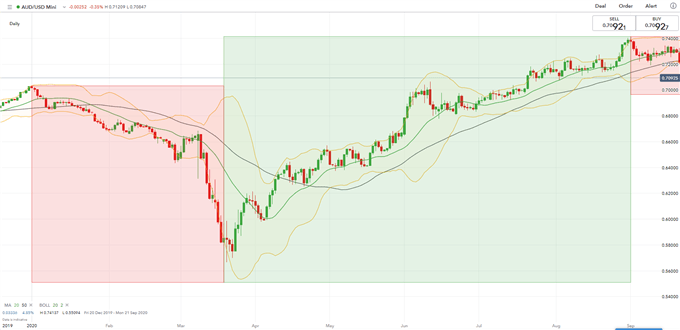AUD/USD TRADING BASICS:
- AUD/USD is liked by forex traders for its liquidity, relatively attractive spreads and link to global economic trends
- AUD/USD often reacts swiftly to economic data and central bank policies, offering numerous trading opportunities
- Key fundamental and technical analysis perspectives are explained, followed by advanced tips for AUD/USD trading
WHAT IS AUD/USD – AN INTRODUCTION
AUD/USD is the abbreviation for the Australian Dollar / US Dollar currency pair. It measures how much US Dollars are needed to purchase one unit of the Australian Dollar. In this case the Australian Dollar (AUD) is the base currency and the US Dollar (USD) is the quote (or “counter”) currency. AUD/USD is one of the most widely traded currency pairs in forex trading and is usually linked to commodity prices and market risk sentiment.
WHY TRADE AUD/USD?
The Australian Dollar is the fifth-most traded currency in the global foreign exchange market, accounting for 6.8% of the world’s forex turnover in 2019, according to the Bank of International Settlement (BIS). The institution compiles statistics in cooperation with central banks and is a good resource to gauge the size of the global forex market. However, it is important to note that non-institutional, or retail and/or individual investors, do not engage in trading directly in the interbank market.
AUD/USD is perceived as a risk-linked, or growth-linked currency. Like the Canadian Dollar or the New Zealand Dollar, AUD can be very sensitive to the movement of commodity prices due to Australia’s large raw materials exports. Here are the main advantages of trading AUD/USD:
Liquidity
- AUD/USD is very liquid as it is one of the most traded currencies in the world. High liquidity allows ease of trade, less slippage, lower costs, and deeper market depth that buffers against external shocks. Forex liquidity is an important consideration for forex traders as it measures the ability of a currency pair to be traded on demand and move without large price variances when bought/sold in significant sizes.
Tight spreads
- As a widely traded currency pair, AUD/USD can have relatively narrow spread for retail traders. This can reduce the overall cost of trading, which is often an important consideration when choosing a currency pair.
24-hour trading
- AUD/USD is tradable 24 hours per day from Monday to Friday, offering seamless trading experience and typically easy entry and exit conditions.
TRADING AUD/USD USING FUNDAMENTAL ANALYSIS
Risk- and commodity-linked currency
- The Australian Dollar is a major risk-linked currency, meaning that it is very sensitive to overall trends in market sentiment. AUD/USD tends to move upwards in favorable market conditions and decline in the face of broad-based market headwinds.
- The price of Australia’s main commodity exports – iron ore, gold, coal, copper - may also influence AUD/USD. Studying these correlations and understanding the fundamental metrics behind the currency pair could improve traders’ performance.
Australian economic data and RBA policy, the influence of China
- The price of AUD/USD reflects the fundamental strength of the Australian currency against the US Dollar, and thus is closely linked with Australia’s economic data tracking employment, GDP growth, consumer confidence, inflation, etc.Keep up to date with economic data releases with our economic calendar. During economic booms, strong domestic growth and robust external demand tend to buoy the Australian Dollar. During downturns, however, slower growth and softer external demand usually results in a weaker AUD/USD.
- Another key driver of AUD/USD is the Reserve Bank of Australia (RBA), whichsets the target short-term interest rate and issues monetary policy guidance on the first Tuesday of each month. A dovish-biased statement and/or an interest rate cut may lead AUD/USD to fall, whereas a hawkish-biased statement and/or an interest rate hike may lead AUD/USD to rise. During economic downturns like the Covid-19 pandemic, the RBA slashed its policy rates to an all-time low of 0.25%, leading the AUD/USD to fall sharply. See the DailyFX central bank calendar for a schedule of upcoming RBA policy announcements.
- AUD/USDcan also move swiftly in response to Chinese economic data, due to the close economic ties between the two countries. Chinese GDP, manufacturing PMIs, industrial production and retail sales figures are among the key data points that influence AUD/USD trading.



HOW TO TRADE AUD/USD USING TECHNICAL ANALYSIS
Depending on a trader’s risk appetite, timeframe, psychology and other preferences, there are various strategies to choose from to best fit one’s need. Here is an illustration of some commonly used technical analysis tools. Please also read a more comprehensive AUD/USD trading guide here.
Identify a trend: up trend, down trend, or no trend
- Traders may prefer to ride a trend and avoid trading in tight range-bound market conditions, because the risk to reward may not be as attractive. Tools to identify a trend may include Simple Moving Average (SMA) lines and Bollinger Bands (chart below).
Simple Moving Averages (SMAs), Bollinger Bands
- Simple Moving Average (SMA) lines calculate the average of the closing price for a selected trading period, like 20- or 50-Day, for example. In an uptrend, SMA lines tend to be sloped upwards and move higher, with the shorter-term SMAs (eg. 20-Day) outpacing the longer-term SMAs (eg. 50-Day). The reverse is true for a downtrend.
- In an uptrend, AUD/USD may trade within the upper half of the Bollinger Band indicator. A flip below the middle Bollinger Band line – which is a moving average - into the lower half may signal a bearish trend reversal (and vice versa).

Chart by IG
AUD/USD MOST ACTIVE TRADING TIMES
Trading AUD/USD is normally busier between 19:00 and 04:00 GMT, which covers late US trading hours to the Asia-Pacific session’s mid-point. Volatility may spike when key macroeconomic data or central bank policy statements are released.
KEY TRADING PARTICIPANTS FOR AUD/USD
Key market participants for AUD/USD trading include banks, financial institutions, commodity trading companies, retail traders, hedge funds and money-changers.



ADVANCED TIPS FOR TRADING AUD/USD
There are various tools a trader can utilize in trading AUD/USD, highlighted below:
Client sentiment
- The IG client sentiment (IGCS) tool offers valuable information about retail traders’ aggregate AUD/USD positioning – either net-long and net-short - within IG. We typically take a contrarian view to crowd sentiment. This means that, for example, AUD/USD may fall if traders are net-long.

Chart by DailyFX
Trading guides and webinars
- DailyFX offers a regular AUD/USD trading strategy webinar
- You may find more useful information in DailyFX trading guides here
--- Written by Margaret Yang, Strategist for DailyFX.com
To contact Margaret, use the Comments section below or @margaretyjy on Twitter





